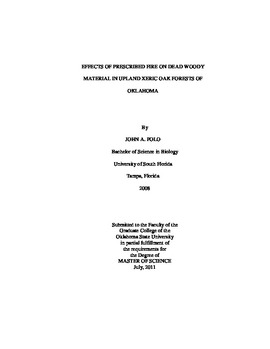| dc.contributor.advisor | Hallgren, Stephen W. | |
| dc.contributor.author | Polo, John A. | |
| dc.date.accessioned | 2014-04-15T21:59:51Z | |
| dc.date.available | 2014-04-15T21:59:51Z | |
| dc.date.issued | 2011-07-01 | |
| dc.identifier.uri | https://hdl.handle.net/11244/9188 | |
| dc.description.abstract | The Cross Timbers of Oklahoma is a xeric oak forest adapted to frequent, low intensity fire. These forests may include tracts of old-growth stands that have been altered due to changes in fire regimes following European settlement. Dead wood comes from the death or breakage of trees and is important for wildlife habitat, nutrient cycles, energy storage, carbon sequestration, and erosion control. Dead wood depends on many factors such as site productivity, stand age, and disturbance. Fire has the capacity to create and consume dead wood. The purpose of this study was to determine whether prescribed burning affected the quantity of standing and down dead wood. We studied three wildlife management areas (WMAs) in central and eastern Oklahoma where prescribed burning had been used as one of the primary management practices. At each WMA, we measured 30 transects in each of 8 burn units with fire frequencies ranging 0 to 4.6 fires / decade over 22 - 26 years. Down woody debris (DWD) was measured by the planar intersect method on 50-m transects, and snags were measured on 500-m2 plots along the same transects. Volume of DWD 7.5 cm diameter was variable across the burn units and sites (7.2-8.7 m3 ha-1). Volume of DWD > 7.5 cm diameter was highly variable among burn units and sites (6.2-9.1 m3 ha-1). The volume of total DWD (13.5-17.7) was approximately equal to that of snags (14.1-18.0 m3 ha-1). Linear regression analyses with fires per decade and years since fire as explanatory variables were nearly all nonsignificant for all the metrics of DWD and snags. Multiple regression analyses with site and live basal area as explanatory variables were likewise not significant. The high variability of DWD and snag volume among burn units suggested that stand structure and local disturbances such as wind, ice, and disease may determine dead wood volumes. | |
| dc.format | application/pdf | |
| dc.language | en_US | |
| dc.publisher | Oklahoma State University | |
| dc.rights | Copyright is held by the author who has granted the Oklahoma State University Library the non-exclusive right to share this material in its institutional repository. Contact Digital Library Services at lib-dls@okstate.edu or 405-744-9161 for the permission policy on the use, reproduction or distribution of this material. | |
| dc.title | Effects of Prescribed Fire on Dead Woody Material in Upland Xeric Oak Forests of Oklahoma | |
| dc.type | text | |
| dc.contributor.committeeMember | Leslie, David M., Jr. | |
| dc.contributor.committeeMember | Lynch, Thomas B. | |
| dc.contributor.committeeMember | Wilson, Duncan | |
| osu.filename | Polo_okstate_0664M_11586.pdf | |
| osu.college | Agricultural Sciences and Natural Resources | |
| osu.accesstype | Open Access | |
| dc.description.department | Department of Natural Resource Ecology and Management | |
| dc.type.genre | Thesis | |
| dc.subject.keywords | cross timbers | |
| dc.subject.keywords | cwd | |
| dc.subject.keywords | oklahoma | |
| dc.subject.keywords | prescribed burning | |
| dc.subject.keywords | snag | |
| dc.subject.keywords | xeric oak forest | |
